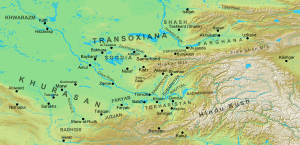Battle of Kharistan
| Battle of Kharistan | |||||||
|---|---|---|---|---|---|---|---|
| Part of the Umayyad-Turgesh Wars and the Muslim conquest of Transoxiana | |||||||
 Map of Khurasan and Transoxiana in the 8th century |
|||||||
|
|||||||
| Belligerents | |||||||
|
Umayyad Caliphate Principality of Juzjan |
Turgesh Khaganate Sogdian princes of Transoxiana |
||||||
| Commanders and leaders | |||||||
| Asad ibn Abdallah al-Qasri |
Suluk al-Harith ibn Surayj |
||||||
| Strength | |||||||
| ca. 7,000 men | ca. 4,000 men | ||||||
The Battle of Kharistan was fought between the forces of the Umayyad Caliphate and the Turkic Turgesh in December 737 near the town of Kharistan in Juzjan, eastern Khurasan (modern northern Afghanistan). The Umayyads under the governor of Khurasan, Asad ibn Abdallah al-Qasri, managed to surprise and defeat the Turgesh khagan, Suluk, and his ally the Arab renegade al-Harith ibn Surayj, thereby forestalling the collapse of Arab rule over Khurasan.
The Umayyads had conquered most of Transoxiana in the early years of the 8th century, but had been increasingly hard-pressed by Turgesh attacks and the revolts of the native princes in the 720s. After a major defeat in the Battle of the Defile in 731, most of Transoxiana was lost, while in 734–736 al-Harith ibn Surayj led a major rebellion against the caliphal governors in Khurasan. The appointment of the veteran Asad ibn Abdallah al-Qasri as governor led to the defeat of Ibn Surayj, but in 737 Asad's attempt to restore control over Khuttal led to a debacle when the Turgesh attacked his army. Although Asad managed to save most of his force, he suffered heavy losses and his army's baggage train was annihilated in the "Battle of the Baggage". Asad withdrew to Balkh, while the Turgesh ruler Suluk, advised by Ibn Surayj, launched a winter invasion of lower Tokharistan. When the Turgesh ruler dispersed his army to raid and gather forage, Asad seized the opportunity to confront him. With 7,000 men he surprised Suluk, who had only about 4,000 troops with him, and defeated him near Kharistan. The Turgesh ruler and Ibn Surayj managed to flee, but his camp fell into Arab hands, and most of the roaming bands of his army were destroyed. This unexpected victory shored up the threatened Umayyad position in Khurasan, while diminishing the prestige of Suluk, who fell victim to inter-Turgesh rivalries in early 738. Asad's successor Nasr ibn Sayyar was able to use the collapse of Turgesh power to restore the Arab position in Transoxiana almost to what it had been before the Turgesh intervention.
...
Wikipedia
